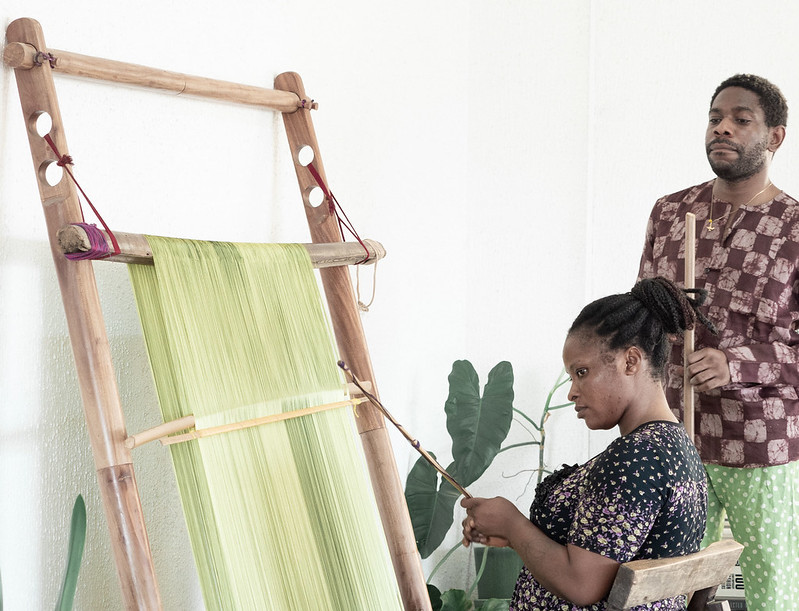In her native Somalia, designer Nimco Adam was known as the Queen of Tie Dye, spending hours plunging fabrics into vats of chemical dyes to use in her collections. Then, one day, she lost her sense of smell.
“It occurred to me that being exposed to all of those chemicals, that I was hurting myself, and the planet, with the work I was doing,” she said from Nairobi, Kenya. “So, really, since then sustainability has become my life and my life’s mission.”
Adam, who has designed for more than 55 fast fashion companies, including retailer Forever 21, has pivoted away from chemicals and synthetic materials. She now uses traditional African textiles woven from hemp, bamboo and even tree bark. Her dyes are natural, extracted from roots, like turmeric. Such changes have put her at the vanguard of the sustainable fashion movement.
“As a designer it has been really important to stop and look at what I was doing, and really owning what it means to be sustainable,” she said. “And that means using what you have, paying fair wages, and finding ways to come together to be smarter and more sustainable in how we design and manufacture.”
Adam is among a growing number of players in the $2.5 trillion global fashion industry who are striving to minimize their impact on the environment. Experts say that is crucial for a sector that is responsible for up to 8 percent of all carbon dioxide emissions and consumes 215 trillion litres of water per year, enough to fill 86 million Olympic-sized swimming pools.
“We need to come together to address the issues that are facing the textile industry if we’re to meet the Paris Agreement targets and Sustainable Development Goals,” says Bettina Heller, Textile Programme Officer at the United Nations Environment Programme (UNEP).
To spearhead such collaboration, the United Nations has created the UN Alliance for Sustainable Fashion. The alliance is an umbrella group composed of several UN and partner agencies, including UNEP, the International Labour Organization and the World Bank Group.
It has been helping the fashion sector to contribute to the Sustainable Development Goals, humanity’s blueprint for a better future, since March 2019. For instance, in Kenya, UNEP collaborated with the International Trade Centre to provide policy recommendations for a more circular textile sector. Kenyan small- and medium-sized enterprises are now benefitting from technical support to innovate their business models and measure their product environment footprint.
UNEP will also be launching a global roadmap for the textile sector that will outline how players throughout the value chain can work together to promote sustainability, said Heller.
New way of doing business
Sissi Chao runs the Remake Hub, a Chinese company that uses recycled plastic to make apparel and consumer goods. Having grown up watching her parents’ garment factories pollute a local river, she dreamed of finding a different way to be part of the fashion industry.
“I had a dream once that I was in the clouds, holding the planet in my hand and it was hot,” said Chao, who started the Remake Hub in 2018. “I woke up and realized that I could not be the second generation of polluters, but that I had to do something sustainable that was also creative.”
The Remake Hub now produces materials for everything from eyewear to clothing to home furnishings. Even her parents have adopted some of her innovative technologies, adding profit to their bank ledgers.
“They were horrified at first because they thought I was just out there collecting trash,” she said. “Now they see what I do as a solution rather than as pollution.”
Leading by example
As an ambassador for Fashion for Conservation, London-based musician Elle L has encouraged similar conversations for the past three years within the British fashion industry.
She thinks states should emulate France, which in February 2020 passed a law requiring clothing companies to follow more than 100 sustainability provisions, including a prohibition on the destruction of unsold goods.
For Nkwo Onwuka and her eponymous brand, Nkwo, sustainability and upcycling were a natural response to the glut of second-hand clothing dumped into the markets in her hometown of Lagos, Nigeria. From the piles of mass-produced denim that landed from overseas, she began to spin her own dakala cloth, weaving together traditional techniques like hand beading with new innovations to produce unique capsule collections.
“COVID-19 presents an opportunity for reconceptualization and retraining of designers but also of consumers,” she said. “It means thinking smaller—not a 60-piece collection, but maybe a 16-piece one, that is beautiful and wearable, made with less waste, by workers who are treated fairly."
That push is being buoyed by a growing demand among consumers—particularly the highly coveted demographic known as Generation Z—for ethical and sustainable fashion.
“We are on the cusp of a mass awakening in consciousness [and] a movement to raise awareness of the power in our purchases,” said Elle L. “As fashion sits at the intersection of art and utility, it has the power and responsibility to create a beautiful solution [post-COVID-19] that helps to stitch back together communities that are healthier, stronger and more artistic.”
Hosted by Sweden, the theme of World Environment Day on 5 June 2022 is #OnlyOneEarth - with a focus on ‘Living Sustainably in Harmony With Nature'. Follow #OnlyOneEarth on social media and take transformative, global action, because protecting and restoring this planet is a global responsibility.
Follow the World Environment Day live feed for updates.













